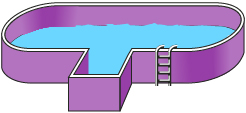Lesson 4
1. Lesson 4
1.4. Discover
Module 7: Volume and Capacity
Discover

pool: Jupiterimages/Comstock/Thinkstock; flowers: iStockphoto/Thinkstock
Landscapers deal with irregular shapes (composite figures) on a regular basis. Flower beds and swimming pools are two such examples.
A landscaper knows that calculating volume and capacity are important skills, since understanding these components helps determine the cost and time required to complete projects. For example, in order to install a swimming pool, the landscaper must estimate the volume of soil to be removed to fit the pool in the ground.
Try This 1
Look at the following custom-designed swimming pool.

To determine the pool’s volume, you need to divide the composite figure into objects for which you have formulas.
- What simple 3-D objects will you divide the swimming pool into? Draw a diagram to show the divisions.
- What formulas will you use to determine the volume of each 3-D object?
- What dimensions will you need to calculate the volume of each object?
- What referents will you use to estimate those dimensions?
- What measuring tools will you need to determine the dimensions?
- What imperial units will you pick to calculate the volume?
Share 1
Share your responses to the questions in Try This 1 with a classmate or with a group of people.
- How did your divisions into simple objects compare with the divisions of your classmate? After viewing other divisions, would you change how you divided up the pool? Was there a division method that made the question easier to solve? If so, what was the division?
![]() Save a copy of your responses to Try This 1 in your course folder.
Save a copy of your responses to Try This 1 in your course folder.